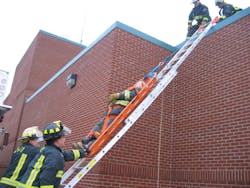Operating on the roof can be a very high-risk area on the fireground. "Making" the roof has to be based on a combination consisting of the construction of the building, experience, skill level and training of the firefighter. Any given number of detrimental events can take place above the fire, which would require a rescue from the roof level (see Photo 1).
The most probable is a firefighter becoming disabled on a roof because of a medical problem such as a cardiac event. It is a very real possibility for a rapid intervention team (RIT) to have to respond to a Mayday from a firefighter on top of a roof. Aerial devices are the ideal medium to establish a high-point anchor or safe-working platform to affect a rescue. As we know, however, it is not always possible to get aerial devices positioned in the most advantageous place. This is especially true when dealing with setbacks, utilities and large trees on residential lots.
There are numerous techniques that have been introduced and are effective for removing injured firefighters from the roof. Developing new concepts and ideas are always necessary for us to operate at the highest level on the fireground, but two of the most effective methods for removing a firefighter from a roof can be found in some of the oldest rescue manuals. These methods at one time were considered basic training in civilian victim removal for firefighters. Revisiting these techniques can possibly lead to success in making a difference on the fireground if the need ever arises.
Rescue Litter Slide
One simple technique that can be utilized for removing a firefighter from the roof involves the use of a rescue litter or Stokes basket, some rope and a ladder to remove an injured firefighter. The litter will simply slide down a ladder at an exaggerated angle while being controlled by a belay. This technique offers the advantage of spinal immobilization for a seriously injured firefighter if needed. The disadvantage is that it can take time to set up properly if not practiced. Remember, to fit into the rescue litter the self-contained breathing apparatus (SCBA) will need to be removed from the back. For that reason, it may not be the number one choice of action when working in a hostile environment, but it is another tool for the toolbox.
To perform the rescue litter slide:
- Attach a rope to the center of the head of the litter. This can be accomplished with a figure eight on a bight or carabiner (see Photo 2).
- Under non-hostile conditions the rope can be run to an established anchor and a device can be used to control the rate of descent. In cases where time is a factor, there is no anchor available or under hostile conditions, a body wrap can be effectively used to control the descent of the litter.
- Once the head of the liter has been secured, the injured firefighter will be placed in it. The firefighter's SCBA will have to be repositioned in order to allow them to be secured in the litter before lowering. This can be accomplished by removing the SCBA and placing it on top of the victim or off to their side in the litter. The firefighter is then secured in the basket by connecting the straps.
- The ladder tip will need to be positioned just below the gutter line at an angle that will be suitable to facilitate the litter sliding down the beams of the ladder. The ladder angle should be exaggerated. Any angle too steep will result in losing control when guiding the litter down (see Photo 3).
- Two rescuers will guide the liter off the roof onto the beams of the ladder while tension is released from the guide line.
- Rescuers at the ground level will receive the litter and transfer care to EMS personnel (see Photo 4).
Rescue Little Removal With Aerial Ladder
This technique can be adapted to be used in conjunction with an aerial ladder when dealing with higher elevations and an aerial platform is not available. Short pike poles or similar tools will need to be secured to the litter to allow it to ride the tops of the rails of the aerial. A firefighter will also need to be positioned on the aerial to guide the litter down to the turntable area (see Photos 5, 6 and 7).
Another technique for removing a firefighter from the roof is the Ladder Fulcrum. Working off a flat roof is a requirement to utilize this method. The main advantage of this technique is that it allows the victim to be lowered in a horizontal position when performed correctly.
Ladder Fulcrum Removal
To perform the Ladder Fulcrum Removal method:
- The RIT will raise a ladder to the roof and ascend with the following;
- Rescue litter
- Rope
- Webbing or "Rescue Loops"
- 5 to 6 carabiners
- Just like the Rescue Litter Slide, the injured firefighter's SCBA will have to be repositioned in order to allow them to be secured into the litter prior to lowering. This can be accomplished by removing it and placing it on top of the victim or off to their side in the litter. The victim is then secured in the litter by connecting the straps.
- The base of the ladder will be set flush against the wall and will be required to have three to four rungs exposed over the roofline (see Photo 8).
- The foot end of the litter will be attached to the second rung exposed over the roofline. This will be accomplished with webbing and carabiners. Rescuers should make certain that there will be enough slack in the webbing to allow the litter to pivot without being caught against the ladder. "Rescue Loops" can be used in place of webbing if available (see Photo 9).
- The head of the litter will have two ropes attached with a figure eight knot or carabiner. This provides the rescuers on the roof a method of controlling the rate and angle of descent for the litter. The rescuers on the roof will control these lines by utilizing a body wrap. (Photo 10)
- The litter is then moved over the edge of the roof while the rescuers at ground level begin to walk the ladder down utilizing a hand-over-hand method (Photo 11). It is imperative that the base of the ladder be tight to the wall at all times and tension be maintained on the guidelines by rescuers on the roof to keep the litter level at all times until it is down on the ground. Slack should be allowed equally on the two lines to lower the litter evenly. The crew leader will have to be positioned at the roof's edge to relay critical information and direction to the rescuers on the guide line once the litter is out of their field of vision below the roof line.
The fireground is a rapidly changing dynamic and we should train to recognize as well as reduce or eliminate risks whenever possible. Any number of events can take place to cause the need to perform a removal of a firefighter from the roof level. The safety of the rescuers as well as time permitted to make a rescue from a roof will dictate as to what technique can be utilized for removal. The only way to find out what works best is to train and practice with numerous techniques before they are needed - is your crew ready for the challenge?
JEFFREY PINDELSKI, a 24-year plus student of the fire service, is the deputy chief of operations with the Downers Grove, IL, Fire Department. He is a Firehouse.com contributing editor and is the co-author of the text: R.I.C.O. - Rapid Intervention Company Operations, and is a revising author of the third edition of the Firefighter's Handbook. Pindelski has earned a masters degree from Lewis University and was a recipient of the State of Illinois Firefighting Medal of Valor in 1998.






